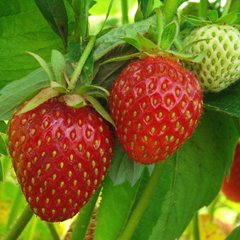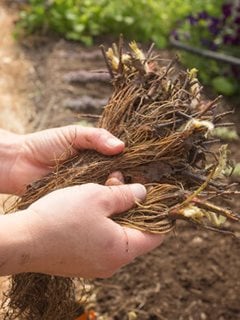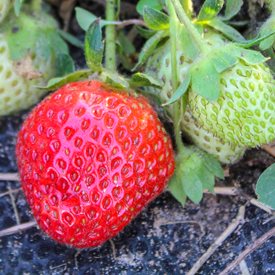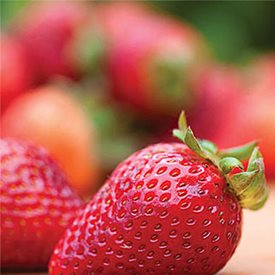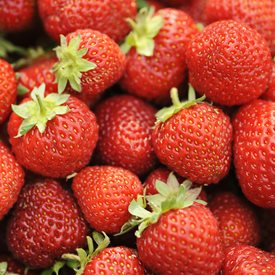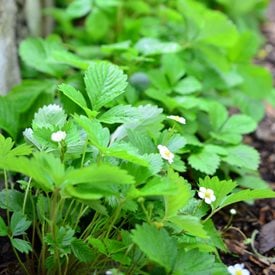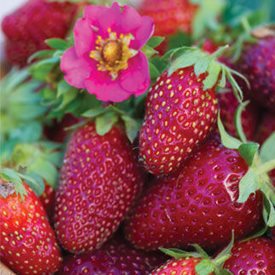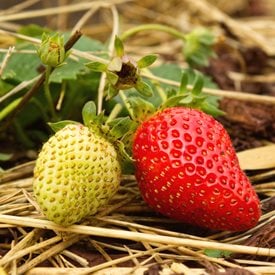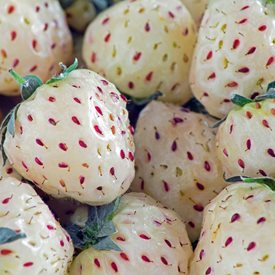Guide to Growing Strawberries at Home
Harvest these flavorful fruits in your own gardenStrawberries are one of the most popular fruits among home gardeners, and for good reason. One of the easiest fruits to grow, they also pack a nutritional punch—high in vitamin C, fiber, and antioxidants. Though fresh strawberries are available in grocery stores in spring and summer, there’s nothing like eating freshly picked strawberries right out of your own garden.
These compact plants can be grown in beds, containers, and hanging baskets. Even gardeners with limited space can add these tasty fruits to their yard, patio, or apartment balcony.
On this page: Basics | Planting | Care | Varieties | How to Choose the Right Strawberry Plant
On this page:
- BASICS
- HOW TO PLANT STRAWBERRIES
- STRAWBERRY PLANT CARE
- STRAWBERRY VARIETIES
- HOW TO CHOOSE THE RIGHT STRAWBERRY PLANT
BASICS
Botanical name:
Fragaria
Zones:
3 to 10, depending on variety; winter mulching is recommended in zones 3 and 4.
Height/Spread:
Low mounding, bushy, vining habit, 6 to 16 inches tall and 12 to 24 inches wide; runners can extend to 40 inches long.
Exposure:
Full sun
Bloom time:
Spring to fall
Color and characteristics:
The leaves are three-lobed, green, with toothed edges. Small flowers are usually white, though sometimes red or pink, with yellow pistils and stamens. Berries are most often red, but also occur in colors of orange-red, yellow, or white. Fruit is sweet and flavorful.
Plant lifespan:
Depends on the variety; with proper care, most strawberries produce for 3 to 4 years. New plants are produced through vining runners.
Toxicity:
All parts of the strawberry plant are safe for pets. If your pet enjoys the taste of the fruit, limit intake so they don’t ingest too much sugar.
Types:
It’s important to know the different types in order to choose the best strawberries for your garden.- June-bearing: Most common; produces heavy crop of large berries in June.
- Everbearing: Not truly everbearing. Produces two main crops: late spring and again late summer to early fall. Fruit slightly smaller than June-bearers.
- Day-neutral: Smaller consistent yields throughout the growing season,from late spring to frost, smaller fruit.
- Alpine: Small, but intensely flavorful berries; everbearing or day-neutral varieties.
- Wild: Berries with superior flavor, North American native.
- Ornamental: Grown mainly for foliage, fruit is insignificant.
Learn more about the different types of strawberries.
How long does it take strawberries to grow?
An existing plant that is coming out of dormancy takes about 2 months to reach its full growth. Plants grown from seed take about 6 months. Different types of strawberry plants will produce fruit at varying intervals from planting—some as early as June, others throughout the summer into early fall (see the types above). In warmer climates, plants should start blooming in early spring. Once the flowers are fertilized by pollinators, berries should ripen in approximately 30 days.
HOW TO PLANT STRAWBERRIES
Strawberries can be grown in raised beds, garden beds, or larger plots. They can also be grown in hanging baskets, containers, window boxes, and strawberry pots. Strawberries can be grown from starter plants, bare root, or seed.
When to plant strawberries:
Plant in spring (around mid-April to mid-May). Wait for the soil to be dried out enough to work and air temperature to be above 40 degrees F.
Where to plant strawberries:
Choose a sunny site with fertile, well-draining soil that will stay evenly moist. Don’t grow strawberries in beds where tomatoes, peppers, or potatoes have recently been grown—the soil can harbor pathogens which can harm new plants.
Planting in beds:
Loosen soil to a depth of 12 inches and add plenty of organic matter to the planting site. Dig a hole big enough not to bend the roots and place plants so the midpoint of the crown is at soil level. Spread roots out slightly and gently fill in the hole with soil; water well. Mulch plants with fresh straw to keep fruit off the ground; this will help prevent rot and slug damage, and keep strawberry beds weed free. Strawberry supports can also be used to keep berries of the ground and prevent rot.
- Matted row system: Most often used for June-bearing varieties, plants are spaced 18 to 24 inches apart with three feet between rows. This allows room to establish new plants from runners beginning in the second year.
- Hill method: Most often used with everbearing and day-neutral strawberries, soil is mounded in hilled rows 8 inches tall, 24 inches wide, and as long as needed. Plants are spaced on the hills 12 inches apart in two staggered rows. Runners are pinched and not allowed to set new plants.
Growing strawberries in containers:
Use a high-quality potting mix and plant the same as for beds. Pots need good drainage. Plants should be spaced 10 to 12 inches apart. These will require more water and fertilizing than plants in the ground. Strawberries can be planted in traditional pots or vertical or stacked planters.
Growing strawberries indoors:
Strawberries can be grown indoors, but this is only recommended for experienced gardeners. Plants will need artificial lighting and hand-pollination for successful berry production.
Growing strawberries hydroponically:
Experienced gardeners may want to try growing strawberries hydroponically, where plants are grown in nutrient-rich water rather than soil. This method can be used indoors, allowing for year-round fruit production.
Strawberry companion plants:
Good companion plants include borage, caraway, and bush beans. Don’t plant strawberries near vegetables in the cabbage family such as broccoli, cauliflower, or kale, as growth can be stunted.
For those with limited space, growing solutions can be attractive as well as functional. Get creative and make vertical hanging planters from galvanized duct pipe as seen in this video from Garden Answer.
STRAWBERRY PLANT CARE
Soil:
Strawberries prefer rich soil that is well amended with compost or other organic matter. Soil should be slightly acidic with a pH between 5.5 and 6.8 (6.2 is ideal). Clay soil with poor drainage can cause root rot.
Amendments & fertilizer:
A few weeks after planting, apply a 10-10-10 fertilizer according to package instructions. For established June-bearing plants, fertilize after harvest is complete. Day-neutral and everbearing types can be fertilized after the second berry crop, but no later than September.
Watering:
Strawberries have shallow roots around 6 inches deep, so it’s crucial to water regularly, particularly during fruit development to promote bigger, juicier berries. Plants need about 1 to 1-1/2 inches of water per week.
Pruning:
Strawberries produce runners, which are thin vining branches that grow from the crown. Remove runners in the first year to put energy back into the plants. Allow runners to grow and develop new plants in the second or third year so they can replace older, non-producing plants.
Thinning and rejuvenation:
Beginning in the second year, cut or mow June-bearing types 2 to 4 inches above the ground immediately after harvest, then fertilize to promote new growth. Thin to allow 4 to 6 inches between plants. For all types, allow runners to establish new plants in the second or third year and remove older unproductive plants.
Harvesting:
Harvest fruits when they are fully colored and firm; don’t allow to become overripe, as fruit will become mushy or moldy. Use soon after harvest or remove the leaf core and freeze for later use.
Diseases and pests:
Diseases include fruit rot, mold, leaf spot, leaf blight, verticillium wilt, botrytis, anthracnose, powdery mildew, and root rot. Pests include slugs, snails, spider mites, cut worms, aphids, whiteflies, weevils, or grubs.
Deer resistance:
All parts of the strawberry plant are attractive to deer. Protect plants as necessary and make sure to wash berries well if your plants have been grazed, as deer can transmit E. coli and other diseases.
STRAWBERRY VARIETIES
HOW TO CHOOSE THE RIGHT STRAWBERRY PLANT
For edible plots and raised beds:
Garden and alpine types are most suitable.
For slopes and hillsides:
Alpine and ornamental strawberries make excellent ground covers and help to stem erosion. Make sure to leave areas where you can step if you plan on harvesting the berries.
For containers:
Alpine and other smaller varieties are best, though any variety can be grown in containers if given adequate space and nutrients. Because water and fertilizer can leach out quickly, plants will need more frequent attention.
For trellises:
Varieties with long runners such as ‘Mt. Everest’ and ‘Skyline’ can be trained to grow vertically on a teepee or trellis.
There are hundreds of strawberry varieties that perform differently depending on region, so it’s best to select cultivars that perform well where you live. Consult your local garden center, extension service, or this state-by-state guide.
RELATED:
Urban Edibles for Rooftop Gardens
Garden Edibles: Success Secrets
14 Summer Vegetables
How to Start an Herb Garden
